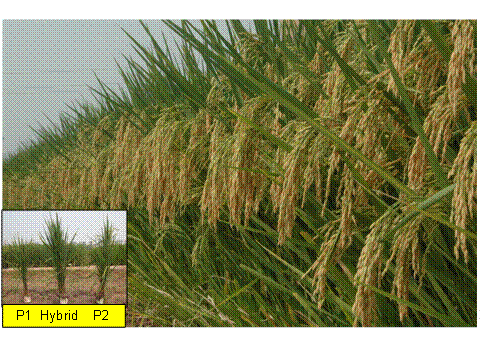The project was led by Zhu Lihuang, Zhu Zhen, both from State Key Laboratory of Plant Genomics and National Center for Plant Gene Research, Institute of Genetics and Developmental Biology, CAS, Yu Jun from Key Laboratory of Genome Sciences and Information, Beijing Institute of Genomics, CAS, and Yuan Longping, from National Hybrid Rice Research and Development Center. Honored as "The Father of Hybrid Rice", Yuan is known for developing the first hybrid rice varieties in the 1970s.
It is estimated that hybrid rice helps to feed tens of millions of population around the globe. Hybrid vigor, or heterosis, is a phenomenon in which some offspring acquire characteristics that make them superior to either parent. Now Wei et al (PNAS, 2009)provide evidence for how a hybrid strain of rice may acquire its agriculturally beneficial traits by comparing global profiles of gene transcription in developing leaves and panicles of superhybrid rice LYP9 and its parental cultivars, 93-11 and PA64s. This analysis of multiple tissues and developmental stages reveals over 2000 genes whose expression deviates from that of the parents.
Clustering results in the study showed that the F1 hybrid's expression profiles resembled those of its parental lines more than what lies between the two parental lines. Out of the total gene set, 7,078 genes are shared by all sampled tissues and 3,926 genes (10.6% of the total gene set) are differentially expressed genes (DG). While DG was divided into those between the parents (DGPP) and between the hybrid and its parents (DGHP), the comparative results showed that genes in the categories of energymetabolism and transport are enriched in DGHP rather than in DGPP.
Mapping DGHP to the rice genome shows that differentially expressed genes are enriched at known quantitative trait loci (QTLs), suggesting that this list might aid in the discovery of genes that underlie important growth characteristics, such as starch content, grain size, and flowering time. Further analysis reveals that the genes most commonly associated with differential expression in the hybrid include those involved in energy and carbohydrate metabolism. In addition, genes that might regulate epigenetic phenomena, such as methylation and acetylation, are well represented.
" Although hybrid vigor is undoubtedly very complex, these findings provide a starting point for uncovering its mechanistic basis in one of the world's most important food crops", Cell, one of the most cited scientific journals, said in its column of Leading Edge.

References
G. Wei et al. (2009). Proc. Natl. Acad. Sci. USA. 106:7695-7701
R.P.Kruger (2009)Cell 137:789



